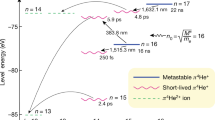Summary
Some atomic and molecular processes which occur when K−-mesons stop and are captured in liquid helium are investigated. It is shown that while the K−-meson is in its initially highly-excited atomic states,S-state capture is predominant.
Riassunto
Si esaminano alcuni processi atomici e molecolari che avvengono quando i mesoni K− si fermano e vengono catturati nell’elio liquido. Si mostra che quando il mesone K− è nei suoi stati atomici di alta eccitazione iniziale, la cattura nello statoS è predominante.
Similar content being viewed by others
References
T. B. Day, G. A. Snow andJ. Sucher:Phys. Rev. Lett.,3, 61 (1959).
T. B. Day, G. A. Snow andJ. Sucher:Phys. Rev.,118, 864 (1960). In particular, footenote (11).
The arguments in references (1) and (2) were semi-classical. A quantum mechanical calculation of the effect for a very closely related model has been performed byF. Gürsey andC. N. Yang with results which agree with references (1) and (2)F. Gürsey: private communication.
J. Leitner, P. Nordin jr.,A. H. Rosenfeld, F. T. Solmitz andR. D. Tripp:Phys. Rev. Lett.,3, 238 (1959).
G. A. Baker jr.:Phys. Rev.,117, 1130 (1960).
E. H. S. Burhop:The Auger Effect and Other Radiationless Transitions (Cambridge, 1952), chap.vii.
K. R. Atkins:Liquid Helium (Cambridge, 1959).
L. I. Schiff:Quantum Mechanics, 2nd ed. (New York, 1955), p. 176.
S. K. Allison:Rev. Mod. Phys.,30, 1137 (1958).
H. S. W. Massey andE. H. S. Burhop:Electronic and Ionic Impact Phenomena (Oxford, 1952).
H. A. Bethe andE. E. Salpeter:Quantum Mechanics of One- and Two-Electron Atoms (Berlin, 1957), Table 15.
R. H. Dalitz andS. F. Tuan:Ann. Phys.,6, no. 3 (1959); andB. R. Desai: unpublished Lawrence Radiation Laboratory report UCRL-9014, University of California, footnote (12).
T. B. Day:Bull. Am. Phys. Soc.,5, 225 (1960) and University of Maryland Physics Department Technical Report no. 175.
This process was considered in another connection byM. A. Ruderman:Phys. Rev.,118, 1632 (1960).
L. R. Maxwell:Phys. Rev.,38, 1664 (1931).
A. A. Evett:Journ. Chem. Phys.,24, 150 (1956).
E. A. Mason andJ. T. Vanderslice:Journ. Chem. Phys.,27, 917 (1957). We would like to express our appreciation to Prof.E. A. Mason of the University of Maryland Institute of Molecular Physics for several informative discussions about these molecules.
See reference (10), chap.x.
H. Hellman:Einführung in die Quantenchemie (Leipzig, 1937), p. 285;R. P. Feynman:Phys. Rev.,56, 340 (1939).
L. Pauling:The Nature of the Chemical Bond, 3rd ed. (Ithaca, 1960).
Considerations similar to those of reference (1) may be applied to liquid deuterium. Here, however, directP=state capture viaS-wave interaction can occur as well. Using the notation of reference (2), the rates for liquid deuterium are\(\begin{gathered} (a)\Gamma _{rad} (6P \to 1S) = 1.6 \cdot 10^{10} s, \hfill \\ (b)\Gamma _{coll}^n (S - Stark) \sim \frac{{3 \cdot 10^{12} }}{n} - (1 - exp[ - 7.5 \cdot 10^3 /n^4 ]), \hfill \\ (c)\Gamma _{coll}^n (P - Stark) \sim \frac{{3 \cdot 10^{12} }}{n} - (1 - exp[ - 10/n^4 ]) \hfill \\ \end{gathered} \). Thus, forn∼10, Γrad(10P)~10Γ 10coll (P-Stark), Γ 10coll (S-Stark)~100Γra1(10P), and there will be no appreciable direct capture fromP-states due to Stark mixing in deuterium.
G. Careri, U. Fasoli andF. S. Gaeta:Nuovo Cimento,15, 774 (1960);K. R. Atkins:Phys. Rev.,116, 1339 (1959);L. Meyer andF. Reif:Phys. Rev. Lett.,5, 1 (1960).
M. Demeur:Nucl. Phys.,1, 516 (1956).
The dipole matrix elements involved in the external Auger rates increase with increasingl for fixed initial and final principal quantum numbers. See ref. (11), p. 264.
M. M. Block, E. B. Brucker, I. S. Hughes, T. Kikuchi, C. Meltze, F. Anderson, A. Pevsner, E. M. Harth, J. Leitner andH. O. Cohh:Phys. Rev. Lett.,3, 291 (1959). We are indebted to ProfessorM. M. Block for repeatedly emphasizing to us the importance of theS-state capture problem in helium.
Author information
Authors and Affiliations
Additional information
This research was supported in part by the United States Air Force through the Air Force Office of Scientific Research of the Air Research and Development Command.
Rights and permissions
About this article
Cite this article
Day, T.B. K−-meson capture by helium. Nuovo Cim 18, 381–394 (1960). https://doi.org/10.1007/BF02725947
Received:
Published:
Issue Date:
DOI: https://doi.org/10.1007/BF02725947




